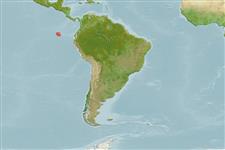Preferred temperature (Ref.
123201): 19.9 - 24.4, mean 23 °C (based on 47 cells).
Phylogenetic diversity index (Ref.
82804): PD
50 = 0.5000 [Uniqueness, from 0.5 = low to 2.0 = high].
Bayesian length-weight: a=0.01479 (0.00671 - 0.03258), b=3.08 (2.89 - 3.27), in cm total length, based on LWR estimates for this (Sub)family-body shape (Ref.
93245).
Trophic level (Ref.
69278): 2.0 ±0.00 se; based on food items.
Widerstandsfähigkeit (Ref.
120179): mittel, Verdopplung der Population dauert 1,4 - 4,4 Jahre. (Preliminary K or Fecundity.).
Fishing Vulnerability (Ref.
59153): Low to moderate vulnerability (35 of 100).
Nutrients (Ref.
124155): Calcium = 49.3 [23.9, 88.7] mg/100g; Iron = 0.587 [0.349, 1.000] mg/100g; Protein = 18.2 [16.9, 19.5] %; Omega3 = 0.0752 [, ] g/100g; Selenium = 29.1 [15.0, 60.9] μg/100g; VitaminA = 40.2 [9.0, 162.8] μg/100g; Zinc = 1.41 [0.95, 2.12] mg/100g (wet weight);
